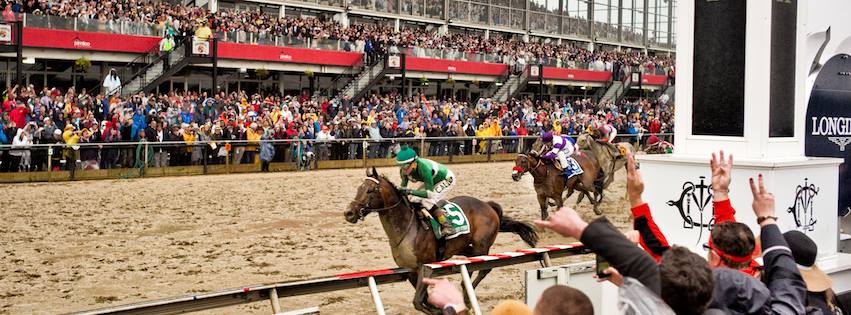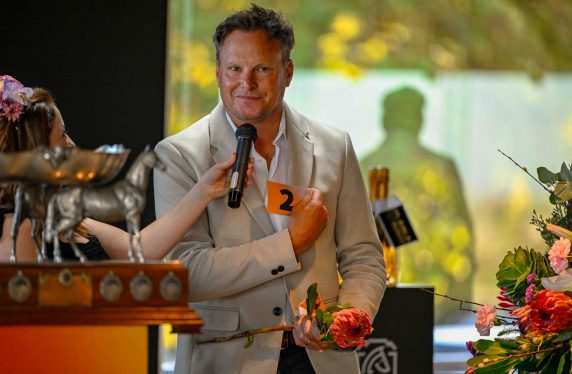Saturday, 20 May 2017 sees the 142nd running of the Preakness at Pimlico Racetrack in Baltimore, Maryland.
A field of 10 will face the starter at 6:48pm, including this year’s G1 Kentucky Derby winner, Always Dreaming. The draws, conducted on Wednesday, 17 May were as follows:-
| 1 | Multiplier | Brennan Walsh | Joel Rosario |
| 2 | Cloud Computing | Chad Brown | Javier Castellano |
| 3 | Hence | Steve Asmussen | Florent Geroux |
| 4 | Always Dreaming | Todd Pletcher | John Velazquez |
| 5 | Classic Empire | Mark Casse | Julien Leparoux |
| 6 | Gunnevera | Antonio Sano | Mike Smith |
| 7 | Term of Art | Doug O’Neill | Jose Ortiz |
| 8 | Senior Investment | Ken McPeek | Channing Hill |
| 9 | Lookin At Lee | Steve Asmussen | Corey Lanerie |
| 10 | Conquest Mo Money | Miguel Hernandez | Jorge Carreno |
Trainer comments
Trainer Brendan Walsh (Multiplier, drawn 1): “It’s the shortest way around. I’d rather that than draw way outside. I don’t think it makes a huge difference, especially to him. He’s been crowded before; he’s been in kick-back before. I think it’s fine. We wanted middle to inside.”
Trainer Chad Brown (Cloud Computing, drawn 2): “I’m fine with the post. He should be able to work out a good trip from there.”
Scott Blasi, assistant to trainer Steve Asmussen (Lookin At Lee, drawn 9; Hence, drawn 3): “In years past, they’ve shown a lot of pace in the Preakness. It’s supposed to be a fast track that day. Both of our horses close. I thought Hence got shuffled back quite a bit in the Derby, farther back than he normally would be. Lee is going to run his race every time. He always does; he tries so hard. We just need a few things to go our way and for there to be some good pace in the race. We’ll see how he breaks and where he positions himself. This track is not Churchill. When the gates open we’ll see where we end up.”
“Lookin At Lee, being the [Derby] runner-up, great race, great ride by Corey Lanerie. He’s proven he belongs with these. He had a troubled trip in the Arkansas Derby or things might have gone a little different there. That being said, he brings his game every time. He’s a blue-collar horse and probably easy to overlook, but not for us.”
Trainer Todd Pletcher (Always Dreaming, drawn 4): “Like I said before, I wasn’t overly concerned about where we drew. He was 4 in the Florida Derby, 5 in the Kentucky Derby. He’s generally a very alert horse away from the gate. He’s a good horse standing in the gate. I guess if you were hand selecting wherever you drew maybe you’d like to be outside of Conquest Mo Money. As we know, in a lot of races things change as soon as the gates open. We’ll just let him run his race. I don’t think [Classic Empire being in Post 5] matters, as long as everybody breaks cleanly. I would imagine that Classic Empire is going to keep an eye on where we are. The first and second choices are side by side.”
Trainer Mark Casse (Classic Empire, drawn 5): “We’ll hope for a good break. Always Dreaming is obviously a very good horse. We just want a fair shot at him. Conquest Mo Money will probably show speed from the outside and Always Dreaming will be right there, but if we break running, we can be there, too. It’s a good post. I wouldn’t have wanted to be right down on the rail, and I prefer not to have been on the outside. The post position wasn’t that big a deal. But I think it’s nice [that the two favorites are next to each other]. It’s nice for the fans, for everybody. Hopefully they both have good trips, break well. It could be interesting. They might go right at it from the start. I like it a lot better being 5 and Always Dreaming being 4 than us being 4 and he’s 5, because that puts Julien (Leparoux) more in the driver’s seat. He can watch, and if we break running and Always Dreaming doesn’t, we may be on the lead. If Always Dreaming breaks running and we break running, if Julien thinks Always Dreaming is running too easy, he’ll go up and engage him earlier. If he thinks he’s running, he’ll sit back.”
Trainer Antonio Sano (Gunnevera, drawn 6): “The post position is good. It is right near the middle. It is two furlongs from the first turn and my horse runs from behind. It’s no easy race, but it’s a different race. There’s not 20 horses; it’s quite a difference.”
Trainer Doug O’Neill (Term of Art, drawn 7): “Lucky 7. He’s a strong, long, good-bodied horse, and I always think with those horses, the less traffic they encounter early on, the better. I think 7 will have to be perfect.”
Trainer Kenny McPeek (Senior Investment, drawn 8): “It’s fine. He’s a closer. I don’t see it being an issue.”
Trainer Miguel Hernandez (Conquest Mo Money, drawn 10): “I like it. The last three times I had all outside positions and the best happened to us. You are out of trouble and you can see how it is going to play. I like that hole. From there, you can go in front or go behind. You can play many, many things.”
About The Preakness
Ogden Nash once wrote that “The Derby is a race of aristocratic sleekness, for horses of birth to prove their worth to run in the Preakness.”
The Preakness Stakes is held on the third Saturday in May each year at Pimlico Race Course in Baltimore, Maryland. It is a Gr1 contest held over 9.5 furlongs (1 3⁄16 miles / 1,900 m) on dirt. Colts and geldings carry 126 lb (57 kg) and fillies are assigned 121 lb (55 kg).
The Preakness Stakes makes up the second leg of the American Triple Crown series and is run two weeks after the Kentucky Derby and three weeks before the Belmont Stakes.
History
Pimlico race track is the second oldest racetrack in America after Saratoga and was ultimately the result of an interesting dinner party proposition made by Maryland’s then Governor, Oden Bowie. In 1868 in Saratoga, New York, Bowie and his prominent racing friends, agreed to race horses that were then just yearlings in two years time to commemorate the evening. The deal was that the winner would host the losers for dinner. Saratoga and the American Jockey Club bid for the event, but Governor Bowie pledged to build a model racetrack in his home state if the race were to be run in Baltimore. And so, Pimlico was built.
Engineered by General John Ellicott, Pimlico was constructed on 70 acres of land, west of Jones Falls; the Maryland Jockey Club purchased the land for $23,500 and built the track for $25,000. The track first opened on on 25 October 1870 and the opening meeting featured the Dinner Party Stakes which was won by a colt named Preakness from Milton Holbrook Sanford’s Preakness Stables in Preakness, Wayne Township, New Jersey.
Pimlico introduced the Preakness Stakes in 1873 and Former Maryland governor Oden Bowie named the then mile and one-half race in honour of the Milton Holbrook Sanford’s colt.
The first Preakness was held on 27 May 1873 and drew seven starters. John Chamberlain’s three-year-old Survivor collected the $2,050 winning purse by galloping home an easy 10 lengths. This stood as the record for the largest winning margin until Smarty Jones won the race by 11 ½ lengths in 2004.
Secretariat, the 1973 winner, and ultimately a Triple Crown winner, was originally credited with a running time of 1:55. Two Daily Racing Form clockers, however, timed Secretariat’s Preakness in 1:53 2/5, a new stakes record. A hearing was held over the time discrepancy, where a video replay showed Secretariat reached the wire faster than Canonero II, the then-current record holder. But instead of giving Secretariat the record, the Maryland Jockey Club decided to split the difference and make its official time that of Pimlico’s clocker, who timed the race in 1:54 2/5. The matter was finally resolved in a June 2012 meeting of the Maryland Racing Commission, which unanimously ruled to change Secretariat’s final time to 1:53 based on testimony and analysis of the race replays. Consequently, Secretariat holds the current official record for all three races required to win the Triple Crown.
Preakness Traditions
The race is also known as “The Run for the Black-Eyed Susans” for the blanket of yellow flowers that is placed around the winner’s neck. However, as it turns out, no black-eyed Susans are ever used. The tradition was started in 1940, when it was proposed to drape the winning horse in a garland of the Maryland State flower, the Black-eyed Susan. Unfortunately, this proved tricky as the race is held before the flowers come into bloom (usually late June / early July). Initially yellow Viking daisies were painted to resemble black-eyed Susans, but this has been replaced by the much simpler solution of using viking poms, a member of the chrysanthemum family instead.
Painting The Weather Vane
As soon as the result is declared, someone is dispatched to the top of the Clubhouse copula to paint the weather vane (a horse and rider) with the colours of the winner’s silks. The colours stay there until the winner is declared the following year.
Trophy
The trophy presented to the winners of the Preakness Stakes is called the Woodlawn Vase.
The trophy was designed by James H. Whitehouse & Eugene J. Soligny at Tiffany & Co and commissioned in 1860 by R. Aitcheson Alexander for the now defunct Woodlawn Racing Association. It passed through various hands, including being buried during the American Civil War, until 1917 when it became known as the ‘perpetual’ trophy for the Preakness Stakes.
The original is 34 inches tall, 29 pounds, 12 ounces. It is set on four tack-trunk formed feet with applied horseshoes, jockey caps, saddles, and crops, supporting a circular domed base with three standing horse figures with fences on a realistically modeled grass ground, with a baluster stem, the upper section with applied figures of Victory holding laurel leaves, with cartouches engraved The Preakness, Pimlico, 1970, Won by Personality, Owner Ethel D. Jacobs, the finial formed as a horse and jockey. The trophy is currently valued at around $4 million, making it the most valuable trophy in American sports. It is kept on permanent display in the Maryland Historical Society and brought to the course ahead of every year’s race by the National Guard. This piece of pageantry now forms part of the event.
While the Woodlawn Vase is presented to the winning connections during the post race formalities, the connections are presented with a 12 inch replica while the original is returned to its permanent residence.
Official song
When the horses for the Preakness are called to the post, the audience is invited to sing “Maryland, My Maryland”. Traditionally, the Baltimore Colts’ Marching Band led the song from the infield, although it is currently performed by the United States Naval Academy Glee Club.
Official drink
Like the Kentucky Derby, the Preakness also has an official drink called, unsurprisingly, the Black-eyed Susan.
The Baltimore Sun’s Rob Kasper wrote “The traditional version, printed in the 1985 edition of The Junior League of Baltimore cookbook ‘Hunt to Harbor,’ called for vodka, rum and triple sec, mixed with orange and pineapple juices. Later versions called for a shot of peach schnapps. Pineapple juice came and went as a favored mixer. Grapefruit juice had a short run. Orange juice has been a constant, but some recipes call for sizeable dose, and others suggest a simple ‘splash.’ ”
The current official Preakness recipe calls for vodka, bourbon, orange juice and sour mix, garnished with an orange and a cherry and if you would like to make your own, you can try the following recipe:-
Ingredients
- 2 ounces pineapple juice
- 1 ounce rye whiskey
- 1 ounce white rum
- 1 ounce orange juice
- 1/2 ounce freshly squeezed lemon juice
- 1/2 ounce rich simple syrup*
- 1 teaspoon orange liqueur
- 1/2 ounce black rum, to float
*To make rich simple syrup, combine two parts sugar and one part water in a pot. Set heat to medium-low and stir until sugar dissolves. Chill before using.
Method
Add all ingredients except for black rum to a glass and stir to combine. Fill a Collins or other tall glass with crushed ice. Add the mixed drink to the glass with ice. Top with the float of black rum. Garnish as desired and serve with a straw.










